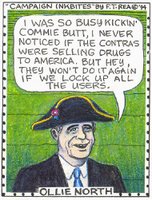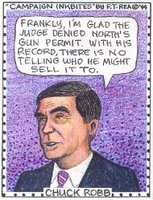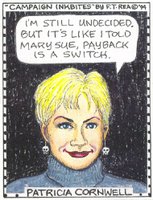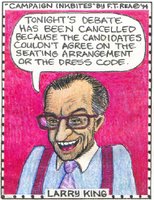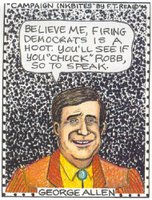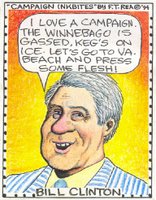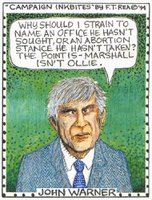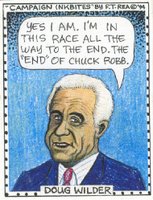FiftyPlus, October 2002
By F.T. Rea
 |
Detail from a postcard-style invitation to Chuck Wrenn’s
40th birthday party on the James River. My art (1985). |
Note: This magazine feature was written 12 years ago by yours truly.
Twenty-two years ago, when it was generally accepted that large-scale outdoor rock ‘n’ roll events couldn’t be staged in Richmond, Chuck Wrenn put three fully-amplified bands, including the impeccably authentic Memphis Rockabilly Band, on a flatbed trailer in the cobblestone alley behind his back yard. It was the fourth edition of High on the Hog, Church Hill’s live music and pork-worshiping festival.
The 1980 event featured a serendipitous, career-defining moment for Wrenn. It began raining. Rather than lose momentum by shutting off the electricity and waiting out the downpour, host/emcee Wrenn broke out rolls of heavy-gauge transparent plastic. Soon, with the help of many happy hands, he had improvised a canopy to protect the stage and cover part of the yard. In effect, he wrapped the whole shebang.
Yes, the show went on. With electric guitars wailing in defiance of the chilly rainstorm, the sense of common purpose felt by one and all was remarkable. And, Richmond’s best-known bartender and most indomitable impresario was emerging as the arbiter of what was valid to a generation of Richmond’s musicians and nightlife aficionados.
To this day, when it comes to rock ‘n’ roll, Chuck Wrenn remains Richmond’s kahuna.
*
Charles E. “Chuck” Wrenn began his love affair with show business in 1964 at the Cary Street Coffeehouse, with its open microphone for folksingers and the like. Then a senior at Hermitage High School, Chuck eventually slid into playing with an amalgam of enthusiasts known as the North Pine Street Jug Band.
Pat Jagoda, organizer of a couple of reunions of the coffee-house gang, was also in high school (Douglas Freeman) when she discovered the small folkie scene emerging in what is now Carytown. Today, Jagoda books talent for the Virginia Museum of Fine Arts' fabulously successful live music series called Jumpin’, a concept that Chuck helped set in motion in the ‘80s by booking the bands for its first three years.
“Chuck has remained true to those very first experiences and brought an amazing group of people into the musical circle for audiences to experience,” Jagoda says. “What has become even stronger since those early years is his passion for music.”
Next, as a fine-art student at Richmond Professional Institute (RPI was the predecessor to Virginia Commonwealth University), Chuck became fascinated with the shifting breeze of popular culture coming from San Francisco, particularly the seminal psychedelic shows at the Fillmore Auditorium. On August 4, 1967, to present their own version of a Happening with music and lights, he and two friends rented Tantilla Gardens on West Broad Street.
The band, put together for the occasion by Ron Courtney, was called Actual Mushroom. The light show was essentially Chuck and fellow art student Eric Bowman using an overhead projector with various props. Chuck’s underground-comix-style art on the handbill touted the promised spectacle as the “first psychedelic dance in Virginia.”
“We sold out, but we lost money,” recalls Chuck. “Yep, been losing money ever since.”
Chuck worked construction jobs and served 3.2 beer in student dives on Grace Street to make money during college. Then, in a Fan District garage, he started a business assembling custom-made stretched canvases called the Square Deal Stretcher Shop.
*
After VCU, Chuck and his wife, Myra, lived on Cape Cod for about a year. He took work as a maintenance man at a seaside national park while she learned to be a bartender, a trade difficult to pick up in Richmond. The concept of serving cocktails, or what had been coined “liquor by the drink,” was still new to Virginia. People had been accustomed to doing their away-from-home drinking in exclusive clubs, neighborhood beer joints, and shot houses (unlicensed bars on the wrong side of the tracks).
When he re-turned to Richmond in 1972, Chuck signed on to become one of the original staff members of the Biograph Theatre, located a block from the VCU campus. Having been chairman of the student film society at VCU, the role of assistant manger at the town’s new repertory cinema fit like a glove. Chuck’s promotional savvy contributed much to the establishment of the midnight show as a staple for the plucky Biograph over its 15-year run (1972-87).
Myra took a bartending job at Poor Richard’s, the city’s first downtown watering hole that had a Georgetown air about it. In the fall of 1973 Wrenn left the movie business to become his wife’s trainee, hoping to learn what he saw as a useful skill in changing times.
Today, Chuck’s first wife and bartending instructor, Myra Daleng, is director of dance in the University of Richmond's Department of Theatre and Dance.
A year later Chuck became head bartender at J. W. Rayle, where he eventually began booking local rock ‘n’ roll bands, hoping to attract customers. It worked. Wood-paneled, with lots of stained glass, Rayle (located at Pine and Cary Streets, on the site of what is now a VCU dormitory), was a huge hit. But it came and went like a comet (1974-77).
In 1978 Chuck began renovating a 100-year-old house on East Franklin Street, which connected him to a new part of town and a lively set of baby-boomer neighbors, who the year before had staged a small neighborhood party they dubbed High on the Hog. Chuck’s band, Faded Rose, graced the second edition, also attended by a small contingent of neighbors and friends.
Chuck’s self-styled role with High on the Hog -- booking bands, serving as emcee, and fronting his own group (later the Megatonz) -- was essential to building what became a mammoth annual party. Anticipating the seventh edition of High on the Hog in 1983, it became clear to its planners that the party had outgrown its location in the alley. But the event had become so popular that it was time to go legit. So with the City’s blessing, it moved across the street to Libby Hill Park.
After nearly a decade of frowning on mixing amplified rock ‘n’ roll with fresh air and beer, Richmond’s official stance had changed. Thus the door was opened for Jumpin‘, Friday Cheers, and the other mainstream music events that are now commonplace in Richmond.
Among the many acts to have appeared on High on the Hog’s stage in the public park, three notables are Billy Price and the Keystone Rhythm Band (1983 and ‘85), NRBQ (1987), and Marcia Ball (2001). On October 12, 2002, High on the Hog No. 26 will feature Julie Johnson and NRG Krysis, plus others. Admission, as always, is free.
*
In 1982 Chuck began a 14-year partnership with friend Barry Gottlieb. In character as Rockin' Daddy (Wrenn) and Mad Dog (Gottlieb), they wisecracked and gave out the scoop on entertainment essentials to 2,500 callers per week, via recordings on a bank of telephone answering machines. The enterprise was known as the Rockline.
“We normally did it [the three-times-a-week tapings] in the morning,” says Gottlieb, now a San Francisco-based writer. “Remember, he usually closed whatever bar he was working at, so he came in after only a few hours sleep. We were efficient, goofy, had fun, rarely if ever did a retake.”
In the mid-‘80s Chuck began putting shows together (in various locations) for Duck Baker, a chum from his Cary Street Coffeehouse days and today a world-class jazz guitarist. Because Baker (still not a rich celebrity) was living in San Francisco or various parts of Europe, those gigs helped to pay for his trips home.
Similarly, while working at Bird in Hand, a Shockoe Bottom restaurant/club in the late-‘80s, Chuck began presenting reunion shows of the Good Humor Band near Christmastime. During the late-‘70s and early-‘80s, that Richmond-based group was one of the most popular touring rock bands on the East Coast. In 1983 they disbanded, and most of the musicians relocated to Nashville.
“I moved from Richmond nearly twenty years ago,” says Mike McAdam, the band’s lead guitarist and founder. “Whenever I visit, I always see my Mom, and I always go have a beer with Wrenn. It confirms the fact that Richmond is still my home. Come to think of it, my Mom and Chuck are nearly the same age. Jeez, I hope they didn’t date in high school, or anything.”
*
In 1992 Chuck became a partner in a new Shockoe Bottom venture called the Moondance Saloon. Due to the stresses of the nightclub business, the original partnership soon fell apart. He took a beating, money-wise, but new partners appeared, Chuck shrugged off his losses, and the show went on.
Manny Mendez, one of the new partners, ran the Moondance kitchen until he left to open his own restaurant, Kuba Kuba, located in the Fan District. Of working next to Chuck for years, Mendez says, “He made it fun! You’re having more fun than the people you’re serving. He never has anything mean to say.”
However, even Chuck’s determination and expertise couldn’t reverse a trend that had the Bottom evolving into a loud, randy, and youth-oriented milieu that intimidated many of the graying music lovers who had made up a significant part of his crowd.
On top of that, the two-headed monster of red tape, the City’s and the Commonwealth’s (ABC Board), persistently hobbled his gritty efforts to keep what was the favorite stage of area musicians from going dark. When the Moondance closed in 1999, Chuck was lucky to get out with his shirt.
Fortunately, at the same time Michael Britt, owner of Poe’s Pub, was looking for a bartender with a following. Since then Chuck has worked at Poe's, located at the foot of Libby Hill Park, doing basically the same thing he’s done for more than twenty-five years: pouring drinks and booking bands. Now he can walk home from work.
Ever the optimist, Chuck took his third trip down the aisle on April 1, 2002. And, for the first time he has become a father. Chuck's wife, Hollie, gave birth to their daughter, Eliza Marie Wrenn, on May 9.
“Chuck has taken like a duck to water to fatherhood” says Hollie, who received an art history degree from VCU in 1995. “He keeps her when I need a break, or go to work. He probably changes more diapers than I do.”
Hollie worked as a waitress at the Moondance and upon Mendez’s departure ran the kitchen. She says Eliza has already been to several live music shows. “Eliza, like most babies, I think, loves music,” says Hollie. “She listens to everything I do, from the Ramones to Mozart. She gets very excited and kicks her legs and moves herself all around.”
Chuck’s reaction to midlife fatherhood? He answers, perceptively: “Rather than changing my life, it’s been a wonderful addition.”
*
How does a silver-haired, bushy-eyebrowed 57-year-old who got his show biz start in a jug band keep up with the latest? Must he follow Britney Spears’ latest warblings, or which titles are climbing the hip-hop charts?
No, he doesn’t. “I book and promote what I understand, what I like,” he says with a smile. And so it continues. The region’s veteran musicians, whether they play rhythm and blues, bluegrass, or an esoteric genre of rock ‘n’ roll, can hardly remember a time when they didn’t rely on gigs that Chuck provided, in one way or another. Craig Evans and Billy Ray Hatley are two of them.
“I don’t know a musician around who has a bad word about him,” says Evans, who plays with The Taters, “which is quite a testimonial for someone in his position.”
“Without Chuck there are a lot of people and bands that would not have gotten their first gig,” adds Hatley, of Billy Ray Hatley & the Showdogs.
Mike McAdam, who has recorded and toured with a number of nationally renown acts says, “He has single-handedly kept true rock ‘n’ roll alive in Richmond.”
When Chuck started putting bands on stage at J. W. Rayles in the mid-'70s, there was no rock ‘n’ roll scene in Richmond, only garage bands playing at private parties. Good musicians left town. In the years since, no one has done more to change that than Chuck Wrenn.
But for his efforts, it’s unlikely he’ll ever get the key to the city.
Chuck shrugs off his triumphs and defeats by snapping off a telling quip about his near legendary career managing Richmond’s night life: “Every night was Saturday night, every morning was Monday.”










